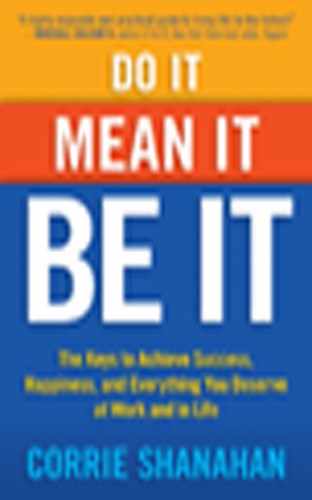NOTES
Chapter 1
1. Martin E.P. Seligman, Flourish: A Visionary New Understanding of Happiness and Well-being (Atria Books, 2012).
2. Malcolm Gladwell, David and Goliath: Underdogs, Misfits, and the Art of Battling Giants (Little, Brown and Company, 2013).
Chapter 2
1. Robert Fritz, The Path of Least Resistance for Managers, 1st ed. (Berrett-Koehler, 1999).
2. W.H. Murray, The Himalayan Expedition (1951).
3. Wolfgang Von Goethe, Faust (Penguin Classics, 2005).
4. Daniel Gilbert, Stumbling on Happiness (Vintage, 2007).
Chapter 3
1. Daniel Kahneman, Thinking Fast and Slow (Farrar, Straus and Giroux, 2011).
2. Malcolm Gladwell, Outliers (Little, Brown and Company, 2008).
3. Angela Duckworth, Grit: The Power of Passion and Perseverance (Scribner, 2016).
4. Carol S. Dweck, Mindset: The New Psychology of Success (Ballantine Books, 2007).
5. Francois Voltaire, Philosophical Dictionary (Penguin Classics, 1984).
6. Winston Churchill, The International Churchill Society, www.winstonchurchill.org.
7. Robert Watson Watt, Three Steps to Victory: A Personal Account by Radar’s Greatest Pioneer (Odhams Press Ltd., 1957).
8. Academy of Medical Royal Colleges, Exercise: The Miracle Cure and the Role of the Doctor in Promoting It (February 2015).
9. Juvenal, Sixteen Satires (Penguin Classics, 1999).
10. Srini Pillay, “Neuroscience Can Help You Live a Healthier Life,” Harvard Health Blog, Harvard Health Publications, Harvard Medical School, February 29, 2016).
11. J. D. Creswell et al., “Alterations in Resting-State Functional Connectivity Link Mindfulness Meditation With Reduced Interleukin-6: A Randomized Controlled Trial,” Journal of Biological Psychiatry 80 (July 2016): 53–61.
12. Gretchen Reynolds, “How Meditation Changes the Brain and Body,” The New York Times, February 18, 2016.
Chapter 4
1. Charles Duhigg, The Power of Habit: Why We Do What We Do in Life and Business (Random House, 2004).
2. Maxwell Malz, The New Psycho-Cybernetics (TarcherPerigee, 2015).
Chapter 5
1. John Helliwell, Richard Layard, and Jeffrey Sachs (eds.), World Happiness Report 2016 (Update, Vol. I). (Sustainable Development Solutions Network, 2016).
2. Paula England, Asaf Levanon, and Paul Allison, “Occupational Feminization and Pay: Assessing Causal Dynamics Using 1950–2000 U.S. Census Data,” Oxford Journals 88, no. 2: 865–891.
3. Valentina Zarya, “The Percentage of Female CEOs in the Fortune 500 Drops to 4%,” Fortune Magazine, June 6, 2016.
4. Occupational Feminization and Pay.
5. Pamela Druckerman, “The Perpetual Panic of American Parenthood,” The New York Times, October 13, 2016.
6. Laura Addati, Naomi Cassirer, and Katherine Gilchrist, Maternity and Paternity at Work: Law and Practice Across the World (International Labor Organization, 2014).
7. Ripa Rashid and Sylvia Ann Hewlett, Winning the War for Talent in Emerging Markets: Why Women Are the Solution Harvard Business Press, 2013).
8. Anu Partanen, The Nordic Theory of Everything ().
9. Daniel Gilbert, Stumbling on Happiness (Vintage, 2007).
10. Martin E. P. Seligman, Flourish: A Visionary New Understanding of Happiness and Well-being (Atria Books, 2012).
Chapter 6
1. Robert Mankoff, How About Never—Is Never Good for You?: My Life in Cartoons (Henry Holt and Company, 2014).
2. Google, “Ten Things We Know to Be True,” www.google.com.
Chapter 7
1. Ernest Hemingway, A Moveable Feast (Scribner, 2010).
Chapter 8
1. Downton Abbey, “Episode Two.” Series 1. Directed by Ben Bolt. Written by Julian Fellowes. ITV, September 26, 2010.
2. Bertrand Russell, In Praise of Idleness: And Other Essays (Vol. 46) (Routledge Classics, 2004).
3. Ibid.
4. Lucy Kellaway, “January Is for Cutting Down on Long Hours, Not Alcohol,” Financial Times, January 24, 2016.
5. Amit Kumar, Matthew A. Killingsworth, and Thomas Gilovich, “Waiting for Merlot: Anticipatory Consumption of Experiential and Material Purchases,” Psychological Science, August 21, 2014.
6. Ibid.
7. James Hamblin, “Buy Experiences, Not Things,” The Atlantic, October 7, 2014.
8. Ernst & Young, Shifting from Consumption to Experience: Winning in the Omnichannel Retailing (2014).
9. Mazda Adli, “Urban Stress and Mental Health,” LSECities, November 2011.
10. Gregory N. Bratman, Gretchen C. Daily, Benjamin J. Levy, and James J. Gross, “The Benefits of Nature Experience: Improved Affect and Cognition,” Landscape and Urban Planning 138 (June 2015): 41–50.
11. Wallace Nicholls, Blue Mind: The Surprising Science That Shows How Being Near, In, On, or Under Water Can Make You Happier, Healthier, More Connected, and Better at What You Do (Back Bay Books, 2015).
Chapter 9
1. Colin Powell, Kids Need Structure TED Talk, January 2013.
2. David Brooks, “The Life Report” and “The Life Report II,” The New York Times, October 27 and November 28, 2011, respectively.
3. Daniel Gilbert, Stumbling on Happiness (Vintage, 2007).
4. Richard Thaler and Cass Sunstein, Nudge: Improving Decisions About Health, Wealth, and Happiness (Penguin Books, 2009).
5. Marshall Goldsmith, Be a Better Leader, Be More Like Your Heroes!, at www.marshallgoldsmith.com.
Chapter 10
1. L. F. Berkman and S. L. Syme, “Social Networks, Host Resistance and Mortality: A Nine-Year Follow-Up Study of Alameda County Residents,” American Journal of Epidemiology 109 (1979): 186–204.
2. John Robbins, Healthy at 100 (Ballantine Books, 2007).
3. Katie Hafner, “Researchers Confront an Epidemic of Loneliness,” The New York Times, September 5, 2016.
4. Emily Dickinson, “The Loneliness One dare not sound,” Emily Dickinson Archive (http://www.edickinson.org/), 1863/1955.
5. Katie Hafner, “Researchers Confront an Epidemic of Loneliness,” The New York Times, September 5, 2016.
6. The Bible, King James Version, Acts 20:35.
7. Elizabeth W. Dunn, Lara B. Aknin, and Michael I. Norton, “Prosocial Spending and Happiness: Using Money to Benefit Others Pays Off,” Current Directions in Psychological Science 23 (2014): 41.
8. Michael Lewis, The Undoing Project: A Friendship That Changed Our Minds (W. W. Norton & Company, 2016).
9. Lisa Feldman Barrett “Youthful Brains in Older Adults: Preserved Neuroanatomy in the Default Mode and Salience Networks Contributes to Youthful Memory in Superaging,” The Journal of Neuroscience, September 2015.
Chapter 11
1. Websters Dictionary
2. www.theodore-roosevelt.com/trsorbonnespeech.html
3. McKinsey and Company, The Power of Many: Realizing the Socioeconomic Potential of Entrepreneurs in the 21st Century, October 2011.
4. Jeffrey Sparshott, “Sputtering Startups Weigh on U.S. Economic Growth,” The Wall Street Journal, October 23, 2016.
5. Ibid.
6. Isaac Newton, Principia Mathematica Philosophiae Naturalis (referenced by NASA at website grc.nasa.gov).
